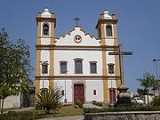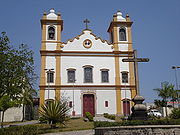
Campo Grande, Rio de Janeiro
Encyclopedia
Campo Grande is a relatively big suburban neighborhood in the Rio de Janeiro
city, among the West Zone of it.
 Campo Grande, which in the early 1940s was considered the "Empire of the Orange", grew along with the settlement of Brazil. The valley, which begins in the Rio da Prata and ends in Cabuçu, was inhabited by Picinguabas and granted by the Portuguese Crown to Barcelos Domingos. In 1673, Domingos built the chapel of Our Lady of the Exile, which later became the parish church
Campo Grande, which in the early 1940s was considered the "Empire of the Orange", grew along with the settlement of Brazil. The valley, which begins in the Rio da Prata and ends in Cabuçu, was inhabited by Picinguabas and granted by the Portuguese Crown to Barcelos Domingos. In 1673, Domingos built the chapel of Our Lady of the Exile, which later became the parish church
of Campo Grande. Near the church was a well also called Our Lady of the Exile, which provided water to the local population.
The region began to grow in 1878 with the inauguration of the Campo Grande railway station, connected to the Estrada de Ferro Central do Brasil
(Brazilian Central Railway). It became easier to reach the center of the city quickly, and the region began to develop at a rapid pace.
On October 16, 1895, Campo Grande began tram
service. On that day, the Municipal Council gave a concession to a private company, the Companhia de Carros Urbanos (Urban Streetcar Company), to install a line using animal power. The goal was to provide transportation to the railway.
In 1915, the company proposed to the Prefecture of the Federal District the substitution of animal power with 48 km of electrified lines, whose trams would leave from the center of Campo Grande for Pedra de Guaratiba
, Ilha
, and Rio da Prata. The line remained in service until October 30, 1967, when trams were removed from Campo Grande.
Campo Grande went from being an essentially rural area to an urban one. Next to Realengo
, Jacarepaguá
, and Santa Cruz
, until 1939 Campo Grande was one of the largest producers of oranges, exporting up to 144,577 tons each year.
fabric of Campo Grande is regular and discontinuous, the habitation of the area consisting in isolated lots of large areas. Owing to the large network of services and a growing level of commerce, Campo Grande grew at an extraordinary pace.
High levels of homeownership are found in Campo Grande. Three-bedroom houses are most common, with an area of 120 square meters. In 1962 and 1979, CEHAB built the Conjunto Santa Margarida on the Estrada do Campinho.
In terms of education, Campo Grande has one of the largest concentrations of students in the Rio de Janeiro (state). The rate of school attendance is satisfactory, as is the rate of enrollment, which has increased yearly.
.
, reaching the Estrada do Pedregoso.
In 1946, Bartolomeu Rabelo founded an aviary that was the birthplace of carioca
bird farming, which today has attained a high level of development.
Some of the companies found in Campo Grande include Ambev, Refrigerantes Convenção, Guaracamp, Cogumelo (metallurgy), Fredvic (heating), Novartis (pharmaceuticals), Sacipan (café Câmara), Michelin, EBSE (electrical fuses), Superpesa (metallurgy), Dancor (munitions) and Ranbaxy (pharmaceuticals).
In Rio da Prata, Mendanha, and Guaratiba
, one can still find agriculture and livestock. Among the most common crops are banana
s, oranges
, mangoes, pears, cassava root, and chayotes. In terms of birds and livestock, one can find goat antelopes, pig
s, cow, and rabbit.
Rio de Janeiro
Rio de Janeiro , commonly referred to simply as Rio, is the capital city of the State of Rio de Janeiro, the second largest city of Brazil, and the third largest metropolitan area and agglomeration in South America, boasting approximately 6.3 million people within the city proper, making it the 6th...
city, among the West Zone of it.
History

Parish church
A parish church , in Christianity, is the church which acts as the religious centre of a parish, the basic administrative unit of episcopal churches....
of Campo Grande. Near the church was a well also called Our Lady of the Exile, which provided water to the local population.
The region began to grow in 1878 with the inauguration of the Campo Grande railway station, connected to the Estrada de Ferro Central do Brasil
Estrada de Ferro Central do Brasil
The Estrada de Ferro Central do Brasil was one of the principal railways of Brazil, uniting the states of Rio de Janeiro, São Paulo and Minas Gerais.-Origins:...
(Brazilian Central Railway). It became easier to reach the center of the city quickly, and the region began to develop at a rapid pace.
On October 16, 1895, Campo Grande began tram
Tram
A tram is a passenger rail vehicle which runs on tracks along public urban streets and also sometimes on separate rights of way. It may also run between cities and/or towns , and/or partially grade separated even in the cities...
service. On that day, the Municipal Council gave a concession to a private company, the Companhia de Carros Urbanos (Urban Streetcar Company), to install a line using animal power. The goal was to provide transportation to the railway.
In 1915, the company proposed to the Prefecture of the Federal District the substitution of animal power with 48 km of electrified lines, whose trams would leave from the center of Campo Grande for Pedra de Guaratiba
Pedra de Guaratiba
Pedra de Guaratiba is a neighborhood of Rio de Janeiro, Brazil....
, Ilha
Ilha
There are parishes that have the name Ilha :-In the Madeira Islands, Africa:*Ilha, a parish in the municipality of Santana-In Portugal, Europe:*Ilha, a parish in the municipality of Pombal...
, and Rio da Prata. The line remained in service until October 30, 1967, when trams were removed from Campo Grande.
Campo Grande went from being an essentially rural area to an urban one. Next to Realengo
Realengo
Realengo is a neighborhood in northern Rio de Janeiro. The lower and middle class neighborhood is between the Mendanha and Pedra Branca mountains...
, Jacarepaguá
Jacarepaguá
Jacarepaguá , with a land area of is the 4th largest neighborhood in the city of Rio de Janeiro, Brazil. In 2000, it had a population of 100,822, making it the 9th most populous neighborhood in the city...
, and Santa Cruz
Santa Cruz, Rio de Janeiro
Santa Cruz is an extensive, populous, mostly low-income neighborhood in the West Side of Rio de Janeiro, the most distant of the central area of the city, at about from downtown Rio. Traversed by the Central do Brasil suburban railway, it has a quite diversified landscape, with rural, commercial,...
, until 1939 Campo Grande was one of the largest producers of oranges, exporting up to 144,577 tons each year.
Development
The cityUrban area
An urban area is characterized by higher population density and vast human features in comparison to areas surrounding it. Urban areas may be cities, towns or conurbations, but the term is not commonly extended to rural settlements such as villages and hamlets.Urban areas are created and further...
fabric of Campo Grande is regular and discontinuous, the habitation of the area consisting in isolated lots of large areas. Owing to the large network of services and a growing level of commerce, Campo Grande grew at an extraordinary pace.
High levels of homeownership are found in Campo Grande. Three-bedroom houses are most common, with an area of 120 square meters. In 1962 and 1979, CEHAB built the Conjunto Santa Margarida on the Estrada do Campinho.
In terms of education, Campo Grande has one of the largest concentrations of students in the Rio de Janeiro (state). The rate of school attendance is satisfactory, as is the rate of enrollment, which has increased yearly.
City of Campo Grande
On June 14, 1968, the locality was officially designated a city under Law #1627, advanced by the deputy Frederico Trotta, though it remained part of the city and municipality of Rio de JaneiroRio de Janeiro
Rio de Janeiro , commonly referred to simply as Rio, is the capital city of the State of Rio de Janeiro, the second largest city of Brazil, and the third largest metropolitan area and agglomeration in South America, boasting approximately 6.3 million people within the city proper, making it the 6th...
.
Industry and Commerce
Commerce in the neighborhood is self-sufficient, attracting business from other regions. The industrial sector is also growing. Campo Grande has an Industrial District on km. 43 of the Avenida BrasilAvenida Brasil
Avenida Brasil is an expressway-like thoroughfare in Rio de Janeiro....
, reaching the Estrada do Pedregoso.
In 1946, Bartolomeu Rabelo founded an aviary that was the birthplace of carioca
Rio de Janeiro
Rio de Janeiro , commonly referred to simply as Rio, is the capital city of the State of Rio de Janeiro, the second largest city of Brazil, and the third largest metropolitan area and agglomeration in South America, boasting approximately 6.3 million people within the city proper, making it the 6th...
bird farming, which today has attained a high level of development.
Some of the companies found in Campo Grande include Ambev, Refrigerantes Convenção, Guaracamp, Cogumelo (metallurgy), Fredvic (heating), Novartis (pharmaceuticals), Sacipan (café Câmara), Michelin, EBSE (electrical fuses), Superpesa (metallurgy), Dancor (munitions) and Ranbaxy (pharmaceuticals).
In Rio da Prata, Mendanha, and Guaratiba
Guaratiba
Guaratiba is a large neighborhood located in Rio de Janeiro. It has one of the city's smallest population densities.-Sub-neighborhoods:Due to its territorial size is divided in sub-regions or sub-neighborhoods:...
, one can still find agriculture and livestock. Among the most common crops are banana
Banana
Banana is the common name for herbaceous plants of the genus Musa and for the fruit they produce. Bananas come in a variety of sizes and colors when ripe, including yellow, purple, and red....
s, oranges
Orange (fruit)
An orange—specifically, the sweet orange—is the citrus Citrus × sinensis and its fruit. It is the most commonly grown tree fruit in the world....
, mangoes, pears, cassava root, and chayotes. In terms of birds and livestock, one can find goat antelopes, pig
Domestic pig
The domestic pig is a domesticated animal that traces its ancestry to the wild boar, and is considered a subspecies of the wild boar or a distinct species in its own right. It is likely the wild boar was domesticated as early as 13,000 BC in the Tigris River basin...
s, cow, and rabbit.
Sub-neighborhoods of Campo Grande
- Adriana (in Portuguese)
- Alessandra
- Amanda
- Amazonas
- Andréa
- Araújo
- Arnaldo Eugênio
- Benjamim do Monte
- BNH
- Carina
- Caroba
- Carobinha
- Carolina
- Comari
- Corcundinha
- Cosmos
- Débora
- Inhoaíba
- Isadora
- Jardim da Luz (in Portuguese)
- Jardim Letícia
- Jardim Nova Guaratiba
- Jardim Paulista
- Jardim Terra Firme
- Joari
- Magali
- Manguariba
- Manuela
- Mendanha
- Monteiro
- Morada
- Morada do Campo
- Moriçaba
- Novo Campo Grande
- Oiticica
- Padre Belisário
- Pedra Angular
- Pedregoso
- Rio da Prata
- Rozendo (in Portuguese)
- Santa Cecília
- Santa Rosa
- Santa Margarida
- Santíssimo
- Santo Antônio
- São Geraldo
- São Basílio
- São Cláudio
- São Pedro
- São Jorge
- São Vítor
- Senador Vasconcelos
- Souza
- Tingüi
- Vila Adelaide
- Vila Eunice
- Vila Izete
- Vila Jardim
- Vila Mariana
- Vila Nova
- Vila Santa Rita
- Vila São João
- Vilar Carioca

